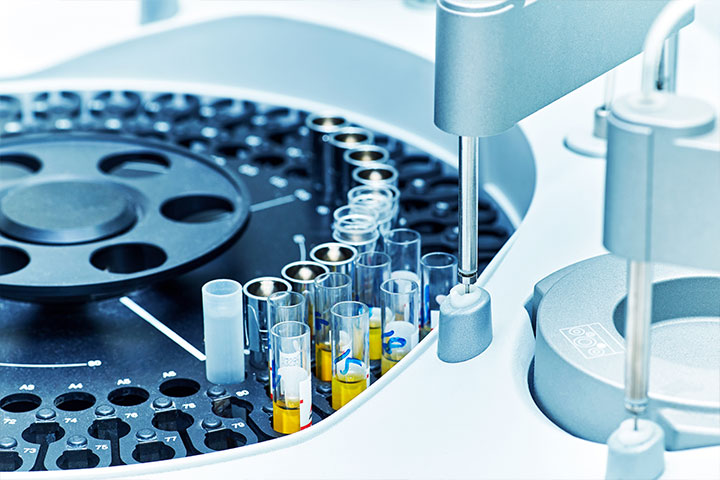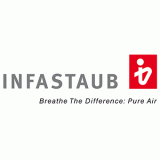
In the Eurasian Economic Union there was no single technical regulation for all chemical substances analogue to REACH in Europe. But now a technical regulation TR EAEU 041/2017 On safety of chemicals was elaborated. It can be seen as a Eurasian REACH.
Chemicals are subject to strict controls by the authorities of the Eurasian Economic Union (EAEU). In this context, various technical regulations have been developed that regulate the production, storage, transport and labeling of chemical substances. The rules are intended to protect human health and the environment.
Application area
Not only the industrial chemicals are regulated but also those from our daily lives, such as cleaning products, paints, cosmetics, clothing, furniture and electrical appliances.
Chemical products are divided into the following types:
- inorganic chemistry (ammonia, ammonium chloride, barium carbonate etc.)
- petrochemical products (stabilized clarified absorbent, petroleum benzene for synthesis)
- organic synthesis products (acetone, technical acetone)
- polymers and copolymers, chemicals and specialty chemicals (Vimol, ethylenediaminetetraacetic acid, etc.)
- mineral fertilizer
- cleaning products
- medicines
Chemical products are also sealants and adhesive mortars, paint and varnish products, lubricants and coolants and others.
Conformity assessment procedure for chemicals
There are different types of conformity assessment procedures depending on the type of a chemical product.
GOST R Declaration
GOST declaration is a compulsory declaration of conformity by which the applicant declares that products manufactured or imported by him are compliant with all the Russian GOST standards and are safe for the consumer. It is relevant for instance for Lubricating oils (petroleum-based), detergents, paints, varnishes, primers and others. The full list of the products which are subject to GOST R Declaration you can find in the Governmental decree from 01.12.2009 № 982.
GOST R Declaration is applied only in the Russian Federation. In other member-states of the EAEU national standards are to apply.
State Registration
For a variety of chemical products, there are uniform requirements that apply in all states of the EAWU. The products listed in the decision of the Eurasian Economic Commission are subject to a state registration. For example, this applies to disinfectants, potentially hazardous chemicals (other than medicines) that can pose a threat to humans and the environment.
Among other things, the following products are subject to the State Registration:
- mineral products for use in the drinking water supply or for contact with food (tariff number 3802)
- agents for accelerating the dyeing or fixation of dyes and other products used in the textile, paper and leather industries (tariff number 3809)
- organic solvents and thinners (tariff number 3814 00)
- antifreeze
- chemical products from group 3824
EAC Statement of conformity
There are a few technical regulations of the EAEU which set requirements for certain chemicals:
- TR CU 009/2011 On safety of perfumes and cosmetic products
- TR EAEU 039/2016 On requirements for mineral fertilizer
- TR CU 030/2012 On safety of lubricants, oils and special fluids
- TR EAEU 041/2017 On safety of chemicals
TR EAEU 041/2017 On safety of chemicals
The Eurasian Economic Commission adopted 2017 a new set of rules to regulate the circulation of chemical substances on the market of the EAEU. The new technical regulation is a counterpart to the European REACH regulation and CLP regulation.
TR EAEU 041/2017 On safety of chemicals comes into force on June 2, 2021.
The regulation introduces some new terms and elements:
- notifications for new chemical substances
- Register of chemical substances and mixtures of the Union
The new technical regulation applies to all chemical substances with the exception of products specified in Annex 1:
- chemical products for scientific research
- natural resources
- medicines
- perfumery and Cosmetics
- chemical substances with ionizing radiation
- foodstuff
Identification and classification of chemical substances is carried out by the manufacturer or importer using IUPAC nomenclature and CAS number. Class (type) of chemical substance is given in the SDS safety data sheet. Safety data sheet must be drawn up before release of chemical products in the customs territory of the EAEU. SDS must be included in the accompanying documentation for chemical products.
More information aboutSDS safety data sheet you can find in our article.
Identification of chemical shall include:
- name of the chemical substance;
- determination whether the chemical is a substance or a mixture;
- determination of the name according IUPAC and the substance identification number CAS for each identified constituent;
- determination of chemical composition of a mixture and determination of the name set out in the IUPAC nomenclature and the CAS number for each identified constituent;
- determination of new substances in the chemical with compositions over 0,1%;
- determination whether the chemical is:
- a new substance;
- substance prohibited or restricted for use on the customs territory of the Union; - determination of the application of the chemical;
- other relevant information.
Tolerance limits for hazardous chemicals
| Content of dangerous chemicals in the composition of chemical products (C),% | Permitted deviations |
|---|---|
| С<= 2,5 | ± 30 |
2,5 | ± 20 |
|
10| ± 10 |
|
25 | ± 5 |
|
The maximum content of the restricted substances in the chemical product
| Type of risk | Concentration (C),% (Weight) |
|---|---|
| Carcinogen (Class 1 and 2) | 0,1 |
| Mutagenic substances (Class 1) | 0,1 |
| Mutagenic substances (Class 1 and 2) | 1 |
| Substances that affect reproductive function (Class 1 and 2) | 0,1 |
| Substances that are toxic to aquatic life (Class 1) | 1 |
Registry of chemicals substances and mixtures of the Union and chemical inventory
The technical regulation TR EAEU 041/2017 establishes a single register of chemicals and mixtures. The manufacturer or importer may, until 2 June 2023, register chemical substances in the register without notification if it is proved that the chemical has already circulated in the territory of the Union before 2 June 2021.
Inventory of chemicals is the first stage of register creation. Chemical substances that are already in circulation or planned to be put into circulation can be registered in a simplified procedure until March 2021. Information from the inventory is then entered in the national part of the register. If a chemical is not listed in the Register, it is considered as a new substance and needs notification.
Notification of new substances
Substances information about which is not available in the Registry of chemical substances and mixtures of the Union must be seen as new chemical and are subject to notification.
The notification is carried out by the accredited bodies. Notification is only necessary for the new chemical substances.
Notification can be carried out only after the entry into force of the technical regulation 041/2017 - after 2 June 2021.
The manufacturer may put the chemical substances into the register without notification until 2 June 2023 if it is proved that the chemical was already circulating in the territory of the Union before 2 June 2021.
The information submitted to the authorized body for the purposes of notification for new substances shall include:
- report on chemical safety
- chemical name set out in the IUPAC nomenclature, also in English
- structural formula of the chemical
- CAS-Number
- results of instrumental analysis of the substance
- purity of the substance;
- intended use of the substance;
- envisaged methods of disposal (recycling);
- transport and measures for emergency prevention and response;
- physical and chemical properties of the chemical;
- toxicity data;
- environmental toxicity data;
- copy of test results
Information about status of the Notification the applicant gets per E-Mail.
Conformity assessment procedure
Chemicals must undergo the conformity assessment before being placed on the market on the market of the EAEU.
There are two forms of conformity assessment of chemicals:
- notifying state registration;
- permitting state registration
Notifying state registration of chemicals shall be carried out when information about the chemical is included in the register of chemical substances and mixtures of the Union.
The validity of a certificate of notifying state registration of a chemical is not limited.
Permitting state registration is required for:
- new chemicals;
- chemicals which contain substances and mixtures included in the inventory of chemical substances and mixtures of the Union which use is restricted in concentrations exceeding the cut-off values given in Annex No. 4 of this technical regulation.
Permit for use of a chemical shall be valid for 5 years since the date of issue. If, within these 5 years, there are no comments from the approved body for link text">non-compliance with the requirements of these technical regulations, the renewal of the registration will be automatic.
EAC mark for chemicals

Chemical substances are to be marked with the EAC Mark.
Label must be in the Russian language and in official languages if necessary. Labels may include supplemental information. Label elements shall be shown on the packaging itself or on a label affixed to the packaging. Elements of precautionary statements shall stand out clearly from other labelling information and shall be in accordance with GOST 31340-2013.
Requirements for labeling of chemicals
Labels shall include the following information:
- name of the chemicals;
- name, location (registered office) of the manufacturer or importer;
- names of substances and mixtures classified as hazardous;
- storage conditions;
- information about hazardous properties of the chemical, including precautionary statement.
Authorized representative
 The manufacturer, which is not established in one of the Member States of the Eurasian Economic Union, is not entitled to apply for any EAC conformity certificate.
The manufacturer, which is not established in one of the Member States of the Eurasian Economic Union, is not entitled to apply for any EAC conformity certificate.
In accordance with applicable law and in accordance with the technical regulations of the Eurasian Economic Union, only an entrepreneur residing in the territory of the Customs Union may be designated as an authorized representative.
In order to get the conformity certificate, the foreign manufacturer must appoint an authorized representative in one of the countries of the Eurasian Economic Union. He represents the interests in the certifying bodies of the Eurasian Economic Union regarding the safety and quality of products and compliance with technical regulations. Our company - Schmidt & Schmidt - offers you an authorized representative on the territory of the Eurasian Economic Union.
Period of validity of EAC conformity assessment certificates
The validity period of the EAC certificate or EAC declaration for chemicals differs depending on the applied technical regulations, the selected scheme, the type of production (serial production, individual delivery, etc.) and equipment and ranges on average from one to 5 years. Those parameters are determined in the respective technical regulation.
Duration and costs for EAC certification
The duration and costs associated with an EAC certificate application for chemicals depend on several different factors, such as the classification of the product, any required laboratory checks and the complexity of all examinations. As such the exact conditions of the EAC certification are always determined individually based on the required documentation.
Please note that an application for an EAC certificate can take several weeks to process.
Delivery of the documentation
If you order the EAC Certificate, you will receive a copy of it via email immediately after our successful certification procedure. The original document and two certified copies will be sent by post.



















































